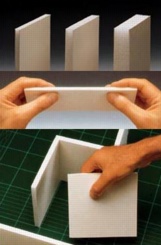 foam core or foam board - A strong, stiff, resilient, and lightweight board of polystyrene laminated
with paper on both of its sides. It
may be any of several thicknesses, in any of a variety of colors. It is
often employed as a surface on which to mount two-dimensional work, and as a material with which to construct three-dimensional work (such as architectural models). Although more expensive
than some other cardboards, it is preferred to them for many qualities, including the ease with which it can be cut. Make straight cuts by using an extremely sharp razor knife on top of a mat or other surface that will not be damaged. Draw the knife toward you along the edge of a metal ruler (with finger tips away from that path). Cuts at each of three successive depths will produce a neat edge to the board.
foam core or foam board - A strong, stiff, resilient, and lightweight board of polystyrene laminated
with paper on both of its sides. It
may be any of several thicknesses, in any of a variety of colors. It is
often employed as a surface on which to mount two-dimensional work, and as a material with which to construct three-dimensional work (such as architectural models). Although more expensive
than some other cardboards, it is preferred to them for many qualities, including the ease with which it can be cut. Make straight cuts by using an extremely sharp razor knife on top of a mat or other surface that will not be damaged. Draw the knife toward you along the edge of a metal ruler (with finger tips away from that path). Cuts at each of three successive depths will produce a neat edge to the board.
Also see adhesives, bristol board, carding, card stock, corrugated cardboard, matboard, oaktag, and packaging.
focal length - In photography, the distance between the lens (its rear nodal point) and the focal plane (the film's or paper's surface).
Also see aperture, camera, f/stop, telephoto, and wide-angle.
focal plane - In photography, an image line at right angle to the optical axis passing through the focal point. This forms the plane of sharp focus when a camera is set on infinity.
Also see aperture, camera, focal length, and f/stop.
focal point - The portion of an artwork's composition on which interest or attention centers. The focal point may be most interesting for any of several reasons: it may be given formal emphasis; its meaning may be controversial, incongruous, or otherwise compelling.
Example:
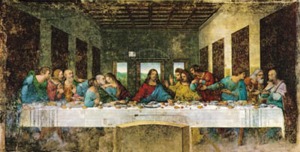
Leonardo da Vinci (Italian, 1452-1519), The Last Supper, 1498, modified fresco, 15 x 29 feet (460 x 880 cm), Convent
of Santa Maria delle Grazie (Refectory), Milan. The overall setting
is highly symmetrically balanced,
its focal point the centrally placed figure of Christ. This is further balanced
by the placement of six
apostles to each side of Christ, even though each man's appearance
is highly individualized. See cenacole
and cenacolo and Renaissance.
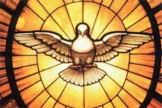
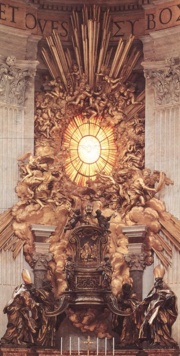
Gianlorenzo Bernini (Italian, 1598-1680),
Dove
of the Holy Spirit, c. 1660.
This stained
glass window is the dramatic focal point of The Throne of Saint Peter, 1657-66, marble, white and
gilt stucco,
and stained glass, overall height
about 100 feet, Saint Peter's Basilica, Vatican, Rome.
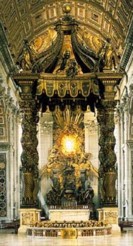
The Throne is a huge Baroque sculptural composition behind the altar, in the apse of the basilica.
When walking toward the Throne of Saint
Peter from the main entrance of the church, a viewer
first sees its
focal point as it is framed
by Bernini's great Baldacchino, 1624-33.
See baldacchino.
Also see arrangement, compare, counterpoint, juxtaposition, principles of design, and weight.
focus - A point of convergence, such as the point at which rays of light converge in an optical system, or from which they diverge; also called focal point. The clarity of an image, such as when rendered by an optical system; or to make an image clear. The typical camera has a focus ring around its lens.
(pr. FOH-kəs)
Also see definition, focal length, focal plane, gestalt, obsession, photography, refraction, and soft focus.
foil - 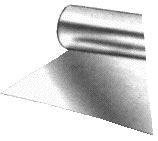 A thin, flexible leaf
or sheet of metal — e.g.
aluminum, copper,
gold, silver,
and tin — often used alone
or adhered (laminated)
to surfaces of other materials,
sometimes for packaging. Also,
a thin layer of polished metal
placed under a mounted gem to
increase its brightness. And,
a person or thing that by contrast
emphasizes or enhances the
distinctive qualities of another.
In architecture, a curvilinear,
often lobelike figure
or space formed between the
cusps of intersecting arcs,
found especially in Gothic tracery and Moorish ornament.
Although comparable to sheet metal,
foil is invariably a much thinner material.
A thin, flexible leaf
or sheet of metal — e.g.
aluminum, copper,
gold, silver,
and tin — often used alone
or adhered (laminated)
to surfaces of other materials,
sometimes for packaging. Also,
a thin layer of polished metal
placed under a mounted gem to
increase its brightness. And,
a person or thing that by contrast
emphasizes or enhances the
distinctive qualities of another.
In architecture, a curvilinear,
often lobelike figure
or space formed between the
cusps of intersecting arcs,
found especially in Gothic tracery and Moorish ornament.
Although comparable to sheet metal,
foil is invariably a much thinner material.
Also see a chart of steel sheet gauges, acetate color, jewelry, manufacture, quatrefoil, scissors, and trefoil.
fold - To bend over so that one part overlaps another part, moving from an extended to a closed position. Or, the act or an instance of folding — a line, layer, pleat, or crease formed by folding.
Examples:
Egypt, c. 1365-1349 BCE (reign of Amenhotep IV-Akhenaton, 18th Dynasty), Body of Nefertiti (?), crystallised red sandstone, height 29 cm, Louvre. The ample but finely chiselled forms give it its originality. The generous proportions of the lower body are emphasized by the radiating folds of the costume, finely carved in red sandstone. often seen in representations of drapery.
![]()
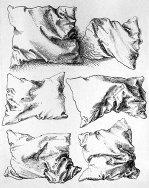
Albrecht Dürer (German, 1471-1528), Sechs Kissen (Six Pillows), 1493, ink on paper, 276 x 202 cm. Dürer produced this wonderful drawing, essentially a study of drapery, when he was twenty-two years old. See hatching and cross-hatching and Northern Renaissance. There is Andreas Freise's (German, contemporary), 2001 95-line ascii version of this picture. (If you don't find it at that first link, try it here). Email Andreas Freise, Universitaet Hannover.

Tokujin Yoshioka (Japanese, contemporary), manufactured by Tokujin Yoshioka, Honey-Pop Armchair, 2000, paper, .1 unfolded: 31 1/4 x 32 x 32 inches (79.4 x 81.3 x 81.3 cm) .2 folded: 31 1/4 x 36 1/2 x 3/4 inches (79.4 x 92.7 x 1.9 cm), Museum of Modern Art, NY. See furniture.
Also see align, angle, bias, corrugate, declivity, folio, form, juxtapose, manipulate, origami, paper, register, rugosity, and shape.
![]()
foliate - Of, relating to, or shaped like leaves. Also, to make (hammering, cutting, etc.) metal into leaf or foil, or to apply leaf or foil to a surface.
Example:

Michel Witz the Younger (Austrian), Three-quarter
armor for a nobleman, made in Innsbruck c.1550, Steiermärkisches
Landesmuseum Joanneum, Graz, Austria. Michel Witz applied a niello decoration
all over this armor
to achieve a Baroque
black and white design with grotesque
masks on shoulders,
elbows and knees, along with foliate motifs everywhere else.
In addition, the armor has been embossed
in part, a process whereby
the metal was hammered and
raised from within, producing
a relief on
the outside.

Howard Pyle (American, 1853-1911), page decoration for the "Seven O'Clock"
chapter heading of his book, The Wonder Clock, 1887,
a rinceau design in pen
and ink. Howard Pyle founded the "Brandywine
School" of illustration.
Among Pyle's students were N.C. Wyeth, Maxfield Parrish, Violet
Oakley, Jessie Willcox Smith and Frank Schoonover.

Jose Antonio Rios (Peruvian, contemporary) and his family, "Colonial Garlands" Jewelry Box, 2003, tooled leather on plywood, velour lining, height 3.0 inches, diameter 6.3 inches, weight 0.4 lbs. A member of the Rios Family has tooled the leather with hammer and chisel, replicating foliate patterns of vines and garlands, reminiscent of Peru's colonial epoch. Jose Antonio Rios said, "For us, embossing leather is a family tradition. My father inherited it from his father, and handed it down to us."
See Art Nouveau, dingbat, and finial.
folio - A book or manuscript of the largest standard size, its height 30-38 cm (12-15 inches), consisting of sheets of paper which have been folded once. What is called a "coffee table book" is often a folio. Folio is abbreviated Fo.
Also see bookbinding, duodecimo, quarto, octavo, sextodecimo, signature, tricesimo-segundo, and vicesimo-quarto.
fontography - The field of font design. A person who designs fonts is a fontographer.
Also see graphic design, letterform, and text.
foot - A supporting base on a vessel, chair leg, etc. Also, a unit of distance measurement equal to a third of a yard, or to twelve inches. To convert feet into meters, multiply them by 0.3048. To convert square feet into square meters, multiply them by 0.0929; into square yards, divide them by 9. To convert cubic feet into cubic inches, multiply them by 1728.0; into gallons (US dry), x 6.42851; gallons (US liquid), x 7.48052. Abbreviated ft. or with a ' (inches can be abbreviated in. or with a ").
Examples of feet in the first sense:

Egypt, Bowl with Human Feet, c. 3750-3550 BCE,
possibly late Naqada I-early Naqada II, Predynastic period, ceramic, height 3 7/8 inches (9.8 cm),
diameter 6 inches (15.3 cm),
Metropolitan Museum of Art, NY. Although this example is a humorously
literal one, it may be misleading: typically the foot of a pot
does not resemble feet! See Egyptian
art.

![]()

China,
Canton, Footed
Bowl, late 18th, early 19th century, crackle-craze underglaze, off-white
and blue, 2 1/2 x 5 3/4 inches, height
of foot 1/2 inch. Enlargement of the inverted view. This was
made expressly for export.
foreground - The area of a picture or field of vision, often at the bottom, that appears to be closest to the viewer. Also, to give priority to one aspect of a thing over another.
Example:

![]()

Pierre-Auguste Renoir, The Luncheon of the Boating Party (Le déjeuner des canotiers), 1881, oil on canvas, 51 x 68 inches (129.5 x 172.7 cm), Phillips Collection, Washington, DC. This painting presents a still life in its foreground as a focal point of this fête galante. The Collection offers The Story Behind the Masterpiece. See genre.

![]()

![]() foreshortening - A way of representing
a subject or an object
so that it conveys the illusion
of depth — so that it seems
to thrust forward or go back into space. Foreshortening's
success often depends upon a point
of view or perspective
in which the sizes of near
and far parts of a subject contrast
greatly. Notice how the head and feet of the man on the phone differ in size. In the black and white hand, note how the shapes of fingers oriented to the side differ from the shape of the finger pointing toward you. The shadow below the foreshortened index finger also helps to convey the direction of this finger's placement.
foreshortening - A way of representing
a subject or an object
so that it conveys the illusion
of depth — so that it seems
to thrust forward or go back into space. Foreshortening's
success often depends upon a point
of view or perspective
in which the sizes of near
and far parts of a subject contrast
greatly. Notice how the head and feet of the man on the phone differ in size. In the black and white hand, note how the shapes of fingers oriented to the side differ from the shape of the finger pointing toward you. The shadow below the foreshortened index finger also helps to convey the direction of this finger's placement.
More examples:

Paolo Uccello (Italian, c. 1396-1475), Battle of San Romano, c. 1450/60, London.
Uccello used foreshortening when painting the figures, horses, and broken spears in this
picture.
Albrecht Dürer (German, 1471-1528), Draftsman of the Lute, 1525, from Albrecht
Dürer, Unterweisung der Messung. Nuremberg, 1525,
leaf Q3, woodcut,
5 1/8 x 7 1/4 inches, Getty Research Institute, Malibu, CA.

Lux Feininger (American, born Germany, 1910-),
Clemens Röseler, c. 1928, gelatin
silver print, 11.3 x 8.9 cm (4 7/16 x 3 1/2 inches), Metropolitan
Museum of Art, NY. "The abrupt foreshortening caused by
the acute perspective makes Roseler's head balloon upward from
tiny feet, emphasizing his self-absorption and his cool detachment
from the world."

Ralph M. Larmann (American, contemporary),
Foreshortened Figure, 1998, computer-generated
painting.
About foreshortening:
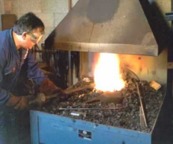
forge - A furnace or hearth, or workshop where metals are heated or wrought; a smithy. To heat and form metal this way.
Here are other depictions of forges:

Francisco Goya (Francisco José de Goya y Lucientes) (Spanish, 1746-1828), The Forge, between c. 1815 and 1820, oil on canvas, 71 1/2 x 49 1/4 inches (181.6 x 125.1 cm), Frick Collection, NY. See Romanticism.
Alfred Sisley (French, 1839-1899), The Forge at Marly-le-Roi, 1875, oil on canvas, 55 x 73 cm, Musee d'Orsay. See Impressionism.
Forged iron:

French, eighteenth century,
Console Table of Forged Iron , 1730-1735,
iron,
35 1/2 inches x 51 1/4 inches (90.17 cm x 130.18 cm), Frick Collection, NY.

Julio Gonzalez (Spanish, 1876-1942), Woman Doing Her Hair 1, c. 1931, forged and soldered
iron, 168.5 x 54 x
27 cm, Georges Pompidou Center, Paris.
Related links:
Also, to make a forgery or counterfeit. Also see anvil, cast, hammers, iron, nail, signature, steel, temperature, and wrought iron.
forgery - Making counterfeits — fraudulent copies of something valuable. Or, a counterfeit. Because fraud is involved, forgery is not to be confused with appropriation.
A resource concerning forgery:
Also see art conservation, copyright, droit moral, ersatz, facsimile, fake, forge, likeness, mirror, paint-by-number, paraph, radiograph, reproduction, signature, simulacrum, and simulation.
forget and forgetting - To lose memory. Forgetting (like remembering) is key to the incubation (Getzel's third) stage in the creative process. At this stage, the artist must mull over the problem in a sort of chaos of ideas and knowledge (remembering), letting go of certainties (forgetting), as the artist engages the intuitive, non-sequential, or global thinking at the core of creativity.
Since before the twelfth century English speakers have employed the word "forget", but in 1815 a synonym for it — "disremember" — first appeared in print. A critic in the 1860s called "disremember" both "obsolete" and "a low vulgarism," and later strict grammarians have typically agreed. As it happens, "forget" is indeed the vastly more popular word, but "disremember" still turns up occasionally, often in dialectal or humorous contexts.
Quote:
Also see déjà vu, destruction, placeholder, and Stendhal syndrome.
formal - Relating to the outward form or structure of a work; not to be confused with "ceremonial" or "stately," since formal elements can be quite informal in character.
Also see classicism, formal analysis, and formalism.
formal analysis - The study of a work of art with reference to its form, rather than to its content or context.
Also see formal and formalism.
formalism - An aesthetic and critical theory of art which places emphasis on form — the structural qualities instead of either content (sometimes called literal or allegorical qualities) or contextual qualities. According to this point of view, the most important thing about a work of art is the effective organization of the elements of art through the use of the principles of design. Also known as structuralism, in the 1960s and early 1970s formalism was so entrenched as the most powerful critical approach, that artists frequently produced works that were particularly attentive to it, and even now some think of modernism as more or less synonymous with formalism. Critic Clement Greenberg (see flat) is frequently cited as an instigating force, but formalism can be traced back through many artists, including J. A. M. Whistler (American, 1834-1903. See aestheticism, art for art's sake, and fin de siècle) to the philosopher Immanuel Kant.
Also see communication, deformalism, emotionalism, imitationalism, isms and -ism, meaning, Minimalism, subject, and viewer.
format - The color scheme, shape, and size of an image. Also see logo.
formication - An abnormal sensation which resembles that of having ants crawling on one's skin. This word is derived from a substance called formic acid, which is produced by ants. This has very little to do with visual culture, but the author is chronically drawn to such word formations as this one.
forum - A central gathering place for the citizens of a city — typically a square (plaza, Platz, etc.) and/or a marketplace. It was a typical feature of ancient Roman cities.
Also see acropolis.
found image, found material, or found object - An image, material, or object, not originally intended as a work of art, that is obtained, selected, and exhibited by an artist, often without being altered in any way. The cubists, dadaists, and surrealists originated the use of found images / materials / objects. Although it can be either a natural or manufactured image / material / object, the term readymade refers only to those which were manufactured. Also known in the French, objet trouvé.
Examples of works incorporating found materials:
Pablo Picasso (Spanish, 1881-1973), Bottle of Vieux Marc, Glass, Guitar and Newspaper, 1913, collage and pen and ink on blue paper, 46.7 x 62.5 cm, Tate Gallery, London. Collages typically include found materials, and Picasso is credited with pioneering it. See Cubism and still life.
Kurt Schwitters (German, 1887-1948), Measure, 1932, drawing on previously printed paper, 15.7 x 12.5 cm, Tate Gallery, London. Schwitters started to produce images with found materials in the early 1920s. For Measure, Schwitters added some line drawing to a portion of a page he found in a magazine.
Kurt Schwitters, Magic, c. 1936-40, collage on paper, support: 13.1 x 10.6 cm, Tate Gallery, London.
Louise Nevelson (American, born Russia, 1899/1900-1988), Sky Cathedral, 1958, found wood assemblage sculpture, painted black, 115 x 135 x 20 inches, Albright-Knox Art Gallery, NY. See feminist art.
![]()
Louise Nevelson, Royal Tide V, l961, found wood assemblage sculpture.

César (born César Baldaccini)
(French, 1921-), Untitled, 1971, collage of found
enameled pitcher and
paint on paper,
70 x 60 cm, Tehran Museum of Contemporary Art, Iran.
John Chamberlain (American, 1927-), Scull's Angel, 1974, welded painted steel, 29 x 45 x 38 inches (73.7 x 114.3 x 96.5 cm), Modern Art Museum of Fort Worth, TX. For this and many other sculptures, Chamberlain used junked automobile parts. Although he has also used other kinds of debris scavenged from the industrial environment, such as paper bags, urethane foam, and Plexiglas — he is best known for his lyrical, evocative assemblages of twisted, crushed metal.
Edward Kienholz (American, 1927-1994) and Nancy Reddin Kienholz (American), Holdin' the Dog, 1986, mixed media , 81 1/2 x 67 x 24 inches, Museum of Contemporary Art, Los Angeles.

Yayoi Kusama (Japanese, 1929-), Baby Carriage, 1964, repainted c. 1966,
baby carriage, cloth, stuffing, silver metallic paint, 38 x 23
1/4 x 40 inches (96.5 x 59 x 101.6 cm), Allen Memorial Art Museum,
Oberlin College, OH. See Japanese
art.

Richard Hunt (American, 1935-), Hero Construction, 1958, found steel, welded and chromed, height 175.3 cm, Art Institute of Chicago. See African American art.
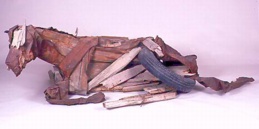
Deborah Butterfield (American, 1949-), Horse
#2-85, 1985, found materials: barbed wire, pipes, fencing,
an old tire, and corroded scraps of metal
and wood, 33 3/4 x 48 x 109 inches,
AZ State U. Art Museum, Tempe.

Michael Lucero (American, 1953-), Greek,
1995, found plaster
cast, ceramic, and metal,
Carnegie Museum of Art, Pittsburgh, PA. The sculptor
found a plaster cast of
an ancient Greek statue.
To this he added his own ceramic pots in place of the head and
arms broken from the original
sculpture long ago.
Quote:
Also see aleatory and aleatoric, collage, memorabilia, mixed media, photomontage, pique assiette (also called picassiette), and tear sheet.
foundry - A workplace where metal is melted and poured into molds. Also see cast, forge, and lost-wax casting.
![]()

![]()
![]() 4-bit image - A digital image with two bits allocated for the storage of each pixel, meaning eight monochromatic colors are possible — a
4-bit image - A digital image with two bits allocated for the storage of each pixel, meaning eight monochromatic colors are possible — a gray scale (or value scale) of sixteen values.
Also see 1-bit image, 2-bit image, 3-bit image, 8-bit image, 12-bit image, 16-bit image, 24-bit image, and 32-bit image.
four-dimensional - The fourth dimension is time. So a thing which is four-dimensional has height, width, depth, and moves, or otherwise changes over a period of time. Dance, theater, cinema, and videos exist in the first (height), second (width) and fourth dimensions. Comic strips, although experienced in the fourth dimension, as we experience everything over a period of time, do not themselves move. (In the fifth dimension, perhaps, might be all aspects metaphysical.)
Related site:
Also see animation, automata, horology, kinesiologist, kinetic, measure, mobile, movement, music, periodicity, rhythm, and space-time.
fourth dimension - Time. See four-dimensional.
fourth wall - See theater.
![]()
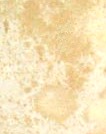
![]()
foxing - A brownish yellow, patchy discoloration of paper caused by the action of mold on iron salts, which are present in most paper. Foxing usually results from high relative humidity — typically when a work is hung on a damp wall. To prevent foxing, mount, mat, and frame using only acid-free materials, keep glass away from the surface of the artwork, and place in a low-humidity environment. Foxing can be treated by a paper conservator, although it is unlikely to be removed entirely by standard cleaning treatments. Also called foxed.
(pr. FAHK-səng)
Also see stain and stain removal.
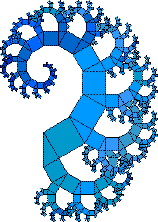
fractal - A geometric pattern that is repeated at ever smaller scales to produce irregular shapes and/or surfaces that cannot be represented by classical geometry. Every part at every scale of a fractal mirrors the whole.
Discovered in the pursuit of chaos theory in the late twentieth century, fractals are used especially in computer modeling of irregular patterns and structures in nature.
Fractals are considered the tenth class of patterns.
Examples:

Fractal generated by an anonymous user of
the Mandelbrot Explorer. Visitors to this page
can try this a program to produce their own fractal images.

Tim Hawkinson (American, 1960-), Untitled, 2003, photomontage of unique digital photographs on foamcore on panel,
68 x 117 inches, collection of Martin and Rebecca Eisenberg. Hawkinson has used his own body as the subject of an image comparable to a fractal. See body art.
Other resources about fractals:
Also see pattern, tessellation, and tile.
fragment - A portion of a whole, a fragment is often what remains of a damaged or ruined object. A fragment of pottery is called a shard. Or, to make fragments.
Examples:
Egyptian, Fragment of a Bust of Amenophis IV-Akhenaton, c. 1365-1360 BCE, sandstone with residues of paint, 1.37 x 0.88 x 0.60 m, Louvre. See bust and Egyptian art.

Greek, Fragment of the Parthenon Frieze, Two Bearded
Heads, c. 440 BCE,
marble, height 26 cm, Kunsthistorisches
Museum, Vienna. See acropolis
and frieze.

Fragment of St. John's Gospel, first half of the second century CE, ink on papyrus, height about 8 cm, John Rylands Library, Manchester, UK. On the side seen here, in Greek, it bears part of verses 31-33. It was discovered in Egypt, and may come from the site of Oxyrhynchus (Behnesa), a ruined city in Upper Egypt. The importance of this fragment to scholars of the New Testament is quite out of proportion to its size, because it is the earliest known fragment of any part of the New Testament in any language.

Iran / Iraq, Persian / Mesopotamian, Umayyad,
Woven Tapestry Fragment, 700-799, wool,
12 x 18 3/4 inches (30.5 x 47.6 cm), Metropolitan Museum of Art,
NY. See pattern and tapestry.
Also see art conservation, art restoration, carve, clean up, destroy, detail, detritus, disfigure, distort, distress, lacuna, and palimpsest.
frame-grabber - See video digitizer.
France - See French art.
free carving - Carving without the use of a pointing machine. Free carving generally follows a drawing on one or more faces of a block. With more and more carved sculptures having been executed by pointing machines after clay models, purists among Western sculptors of the early twentieth century used this term in an effort to recognize the fundamental difference between the processes of modeling and carving.
freedom of expression - See First Amendment rights.
freehand - Drawn by hand, without the use of any mechanical device — without the aid of a straight-edge, compass, protractor, French curves, computer equipment, etc. — and also without tracing. Freehand is the opposite of mechanical drawing. Also see line.
freelance and freelancer - A freelancer is an artist, typically a graphic artist or designer, who sells his or her work to an employer without any long-term commitment to any one of them. Selling work in this way is doing freelance work.
Related resources:
Also see agent, art buyer, art director, artists' organizations, art law, and commodity.
freestanding sculpture or free-standing sculpture - A type of sculpture that is surrounded on all sides by space. Also called scupture in-the-round.To be viewed from all sides; freestanding. The opposite of relief.
freezing point - The temperature at which a substance solidifies as it cools. For instance, the temperature at which water turns to ice — water's freezing point is 32° F., 0° C.
Also see alloy, climate control, hygrothermograph, measurement, melting point, and metal.
![]()
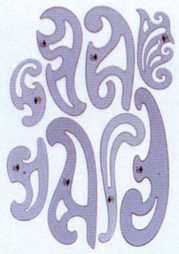
![]()
French curve - Any of several flat
drafting tools, shape template
with curved edges
and voluted cutouts,
used to draw curves, especially in
mechanical drawing. Eight popular designs,
each between 6 and 12 inches long. French
curves inspired a series of works by Frank Stella (American, 1936-),
in the early 1980s.
Also see Minimalism, pattern, and stencil.
fret - An ornament, usually in bands but also covering broad surfaces consisting of interlocking geometric motif. Also called a meander, or Greek key, or Roman key, or gather, or wall of Troy pattern.
Also see openwork.
frigidarium - The cold-bath section of a Roman bathing establishment.
Also see Roman art.
frisage - See marquetry.
![]()

![]() frisket - A masking device or material used especially in airbrushing, in photography, in the graphic arts, and in printing. It often refers to a paper or film used to shield areas of an airbrush painting from spray, or printing paper from ink, or photographic paper from light.
frisket - A masking device or material used especially in airbrushing, in photography, in the graphic arts, and in printing. It often refers to a paper or film used to shield areas of an airbrush painting from spray, or printing paper from ink, or photographic paper from light.
On a hand-operated press, a frisket is a thin frame that keeps a sheet of paper in position and masks any portions not to be printed during the act of printing.
This word came from the late 17th century French word frisquette, in turn derived from the Old French frisque, meaning "lively."
(pr. FRISS-kət)
Also see transfer paper.
frisson - A feeling of excitement, usually brief. Although somewhat pleasureable, this sensation is caused by fear or the expectation that something is going to happen. It comes from a French word for shiver, from Old French friçon, from Late Latin friction-, frictio; which in turn came from Latin, literally, friction. It was first used as an English word in 1777.
(pr. free-SOHn)
Also see aesthetic experience, compare, dissonance, edge, expression, grotesque, incongruity, interesting, juxtaposition, pain, and tension.
frontal - The head-on view of a person or object.
Example:
Each of these three photos was taken of the same
woman, but each with a different lens -- left: wide-angle,
center: normal, right: telephoto.
Each of these frontal views was printed
so that the eyes would be the same distance apart. The subject
is narrowest with the wide-angle lens, and widest with the telephoto
lens. Which photo is the best shot?
See portrait, profile, and three-quarter view.
frottage - The technique of rubbing with crayon or graphite on a piece of paper which has been placed over an object, or an image achieved in this way. Also simply referred to as rubbing. Such impressions are usually made from such highly textured subjects as leaves, wood, wire screen, gravestones, and manhole covers. It was a technique especially employed by surrealists, one of whom, Max Ernst (German, 1891-1976), first introduced frottage in his works in 1925, often employing such rubbings as part of a collage, or combining frottage with painting techniques.
(pr. frə-TAHZH)
Quote:
Example:
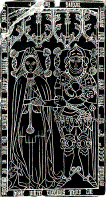
English (Barlow, Derbyshire), Memorial to Robert and Margaret Barley,
1467, incised brass
plaque, represented by frottage.
Robert Barley is wearing the Yorkist collar of suns and roses
is shown, attesting the deceased's connections with the Yorkist
royal line.
Brass rubbing in Britain has become so popular, and caused such wear to old plaques, that access to most original brasses has been restricted. Today, those interested are typically charged fees for making rubbings from resin reproductions. See costume, lacuna,and memorial.
Related link:
Also see bricolage, collage, coulage, découpage, femmage, fumage, gyotaku, montage, parsemage, and photomontage.
FSA - Acronym for the Farm Security Administration, an agency of the U.S. government in the Agriculture Department during the Great Depression of the 1930s and 1940s. It was a part of the federal bureaucracy which administered New Deal art programs. It had earlier been the Resettlement Administration (RA).
f/stop - In photography, the focal length of a camera divided by the diameter of its aperture. Knowing the f/stop, a lightmeter can measure the light on the subject, and calculate the exposure time.
ft. - Abbreviation for foot or feet.
fugitive colors - Short-lived pigments and dye — capable of fading or changing, especially with exposure to light, to atmospheric pollution, or when mixed with certain substances; in each case the result of a chemical change. Examples are the colors in magazine photographs and inexpensive construction papers, especially the yellows, and then reds. While student works are generally forgiven the use of such inexpensive poor-quality pigments, professional artists' works are expected to be made with permanent pigments.
(pr. FYOO-jə-təv Kə-lərz)
Tubes and other containers of paint are sometimes labeled with a code indicating a color's degree of permanence:
|
letter code |
degree of color permanence |
|
AA |
highest |
|
A |
standard |
|
B |
less than standard, though fairly durable |
|
C |
fugitive |
Also see archival image.

fulcrum - A prop or support for a lever or a balance-beam. An example is the red form in this picture.
full round - Sculpture in full and completely rounded form, usually intended to be seen from all sides. Also called sculpture in the round. The opposite of full round is relief.
full-scale - Actual or full size. In the case of an animal or human figure, this is also called human scale or lifesize.
Also see épure, human scale, maquette, measure, model, plan, pointing machine, replica, representation, reproduction, scale, and visual scale.
full-screen image - A digital image covering the entire screen of a workstation monitor.
fumage - A method of making an image with smoke fumes. Fumage was invented by Wolfgang Paalen, whose first fumages were made with a kerosene lamp. When surrealist painter Salvador Dali (Spanish, 1904-1988), made a fumage, he called the method sfumato; and some have spelled this term "sfumage". Very few artists have worked in fumage. (fyoo-MAHZH)
Example:
Burhan Dogancay (1929-), A Wall in Sofia, 1993, fumage, collage, and painting, 57.5 x 57.5 inches.
Also see aleatory and aleatoric, collage, coulage, femmage, funk art, montage, parsemage, and photomontage.
![]()
fumigant
and fumigation - A chemical used to treat an object,
group of objects, or structure
for elimination of pests or mold, and such a treatment. Camphor
flakes, naphthalene, and
paradichlorobenzene are three
such fumigants.
(pr. FYOO-mə-gənt, FYOO-mə-GAY-shən)
Also see art conservation, ASTM International (American Society for Testing and Materials), Material Safety Data Sheet (MSDS), preparator, and storage.
function - Refers to the intended use or purpose of an object. The term is often applied to manufactured products, particularly crafts, and when discussing designs for architecture. Though sometimes said to be non-functional, art is expected to function in various ways, including: to beautify, to adorn, to express, to illustrate, to mediate, to persuade, to record, to redefine reality, to redefine art, to provide therapy, to give unselfconscious experience, to provide paradigms of order and/or chaos, and to train perception of reality. Anything that is not functional is called nonfunctional. Often the decorative qualities of a thing are considered nonfunctional.
Examples:
Lucas Samaras (born Greece, works in America, 1936-), left: Chair Transformation Number 12, l969-70, synthetic polymer on wood, 41 l/2 x 36 x 13 inches (105.4 x 91.4 x 33 cm); right: Chair Transformation Number 16, 1969-70, synthetic polymer on wood, 39 x 15 x 28 inches (76.2 x 38.1 x 71.1 cm); both Whitney Museum of American Art, NY. Samaras called his series of chair-sculptures transformations because each subverts the usual function of a chair.
Quote:
Also see advertising, basket, commercial art, communication, diagram, graph, map, pattern, and plan.
funk art - A term used loosely for art in which offensive subject matter is presented in order to offend, sometimes pornographically. It gained this association in the 1960s, when used to refer to such work produced in the San Francisco area. The word "funky", from which this term was derived, has older, wide-ranging meanings, including: having a moldy or unwashed odor; smoky or earthy qualities in music, as in the blues; self-expressive, original, and modish; unconventional, outlandishly vulgar or eccentric in a humorous or tongue-in-cheek manner; campy.
Also see aesthetic, bad art, beauty, fumage, grotesque, kitsch, obscene, and ugly.
fusain - Fine charcoal in stick form, made from the wood of a spindle tree. [Do you know if this is the same or different from what is called "willow" or "vine" or "lime" charcoal? Please tell me how you know. - email ] The wood is dried and carbonized in an airtight container. The duration of its burning determines its hardness — a longer period makes it softer. A fusain can also be a sketch or drawing made with this charcoal, often either as a finished work on paper, or as a drawing over which an artist will paint. Fusains must be fixed. This English word was absorbed from the French, who had adopted the Latin word for spindle, fusus.
(pr. fyoo-ZAYN, FYOO-zayn)
Also see chalk, conté crayon, crayon, pastel, and pencil.
fuse, fusion - To melt; two or more materials joining at a molecular level. "Fusion" may also refer to the combination or blending of other things, such as styles or subjects. An example of this in the classical orders is the composite order.
(pr. FYOOZ, FYOO-zhən)
Also see adsorption, adhesives, alloy, encaustic, fire, flux, Fluxus, glass, glaze, kiln, metal, pastiche, polymer clay, soldering, temperature, and welding.
fusuma-e - In Japanese art tradition, paintings on sliding wall panels. Because the materials with which sliding screens are made are short-lived, these works are considered to be temporary ones.
Example:
![]()

![]()
Kano Geki, Fusuma-e in a residence, Kyoto. More fusuma-e by Kano Geki.
See time.
https://inform.quest/_art